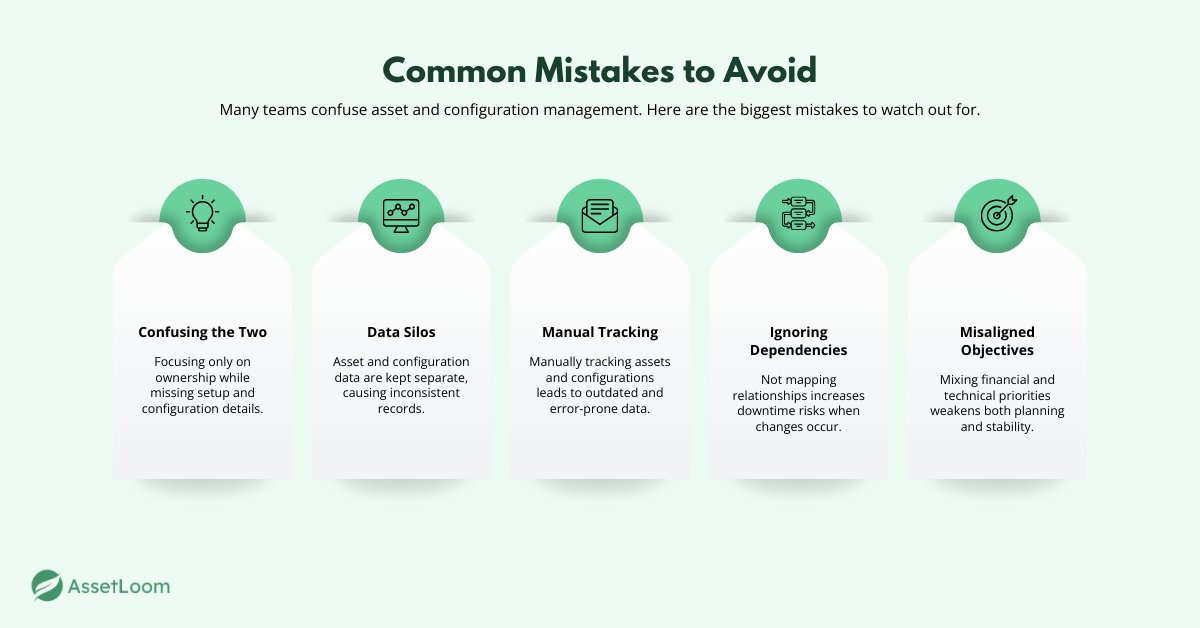Asset Management vs. Configuration Management: Key Differences Explained
Understand the key differences between asset management and configuration management and how they work together in IT.
When IT teams don’t clearly separate asset management from configuration management, problems start piling up. Assets go missing, costs spiral out of control, and system changes break things unexpectedly.
These issues often happen because no one knows exactly what the company owns or how those resources are set up. The result? More downtime, higher risks, and frustrated teams.
In this article, we’ll look at the key differences between asset management and configuration management, and how understanding both can prevent costly mistakes.
What is Asset Management?
Asset management is the process of tracking and managing all the resources a company owns, from laptops and servers to software licenses and cloud subscriptions. It works by keeping a complete record of each item throughout its lifecycle - when it’s purchased, assigned, maintained, and eventually retired.
The main purpose of asset management is to give businesses clear visibility into what they own, how those resources are being used, and what costs are involved. This helps reduce waste, improve planning, and keep assets secure and compliant.
In practice, asset management involves collecting key details such as hardware specifications, ownership, warranty information, and license usage. For example, when an employee leaves, it makes it easy to know which devices and accounts need to be returned or reassigned.
Put simply, asset management ensures that IT resources are always accountable, cost-effective, and properly maintained. This process is often supported by IT asset management (ITAM) tools, which help organize and automate the tracking.
What is Configuration Management?
Configuration management is the process of keeping track of how IT systems are set up and how different components work together. While asset management focuses on what you own, configuration management looks at how those assets are configured and connected within the IT environment.
It works by recording details about configuration items (CIs) - such as servers, operating systems, applications, and network devices - and storing them in a central database, often called a Configuration Management Database (CMDB). Many organizations use CMDB discovery tools to automatically detect these items, capture their configurations, and map relationships between them. This reduces manual effort and keeps the data accurate.
The main purpose of configuration management is to maintain consistency, reduce errors, and make changes safer. When IT teams know exactly how systems are set up, they can avoid unexpected disruptions during updates, troubleshoot issues faster, and stay compliant with policies.
For example, if a server goes down, configuration management helps identify all the systems and applications that depend on it. This visibility makes it easier to prioritize fixes and prevent ripple effects across the business.
In short, configuration management ensures IT environments remain stable, predictable, and easier to control.
Core Differences Between Asset Management and Configuration Management
Although they sound similar, asset management and configuration management focus on two very different sides of IT. Understanding these differences helps avoid confusion and ensures both processes are used effectively.
Asset management is about ownership and value. It answers questions like: What hardware and software do we own? Who is using them? How much are they costing us? When do they need to be replaced? It’s strongly tied to budgeting, compliance, and making sure nothing goes unaccounted for.
Configuration management, on the other hand, is about setup and relationships. It answers questions like: How is this server configured? Which operating system version is it running? Which applications depend on it? What happens if we change or remove it? It’s less about cost and more about keeping systems stable and predictable.
In other words:
-
Asset management deals with what you own and how it is used as a resource.
-
Configuration management deals with how those resources are structured and connected in the IT environment.
For example, asset management might tell you that you have 200 laptops in your inventory, while configuration management would tell you that a specific laptop is running Windows 11, has encryption enabled, and connects to certain network resources.
Both are important, but for different reasons: asset management protects financial investment, while configuration management protects operational stability.

How They Work Together in IT Operations
Asset management and configuration management may focus on different data, but in daily IT operations, they work best when combined. Asset data shows the business side - what resources exist, how much they cost, and who is responsible. Configuration data shows the technical side - how those resources are set up and how they interact.
Together, they give IT teams a complete view. For example:
-
When a new server is purchased, asset management records its cost, warranty, and ownership. Configuration management then documents its operating system, installed applications, and dependencies.
-
When an employee leaves, asset management ensures their laptop and software licenses are collected, while configuration management confirms the device is wiped, patched, and configured properly for reassignment.
-
During incident response, asset management identifies which devices are involved, and configuration management shows how they connect to other systems, making it easier to contain issues.
This combination prevents blind spots. Without asset management, companies lose track of costs and ownership. Without configuration management, they risk downtime and security gaps. Used together, they create a clear, reliable foundation for IT operations.
Common Mistakes to Avoid
Organizations often blur the line between asset management and configuration management. Here are common mistakes to watch out for:
-
Treating them as the same thing: Asset data shows ownership and cost, but without configuration details, you can’t see how systems are actually set up.
-
Working in silos: When asset and configuration teams don’t share data, costs, and system details become inconsistent.
-
Relying only on manual updates: Manually tracking assets and configurations leads to outdated records. Automated discovery tools help keep data accurate.
-
Ignoring relationships between systems: Knowing what you own isn’t enough; dependencies need to be mapped to prevent downtime from changes.
-
Not aligning with business goals: Asset management should guide financial planning, while configuration management should ensure stability. Mixing priorities weakens both.

Conclusion
Asset management and configuration management may sound similar, but they solve different problems. Asset management gives businesses visibility into what they own, who uses it, and how much it costs, while configuration management ensures systems are set up correctly, connected properly, and running reliably.
When combined, they provide both the financial and technical perspectives needed to manage IT effectively. This balance reduces waste, improves stability, and makes compliance easier.
In short, treating them as complementary, not interchangeable, helps organizations get the most value from their IT resources while keeping operations secure and efficient.

Subscribe for Expert Tips and Updates
Receive the latest news from AssetLoom. right in your inbox

